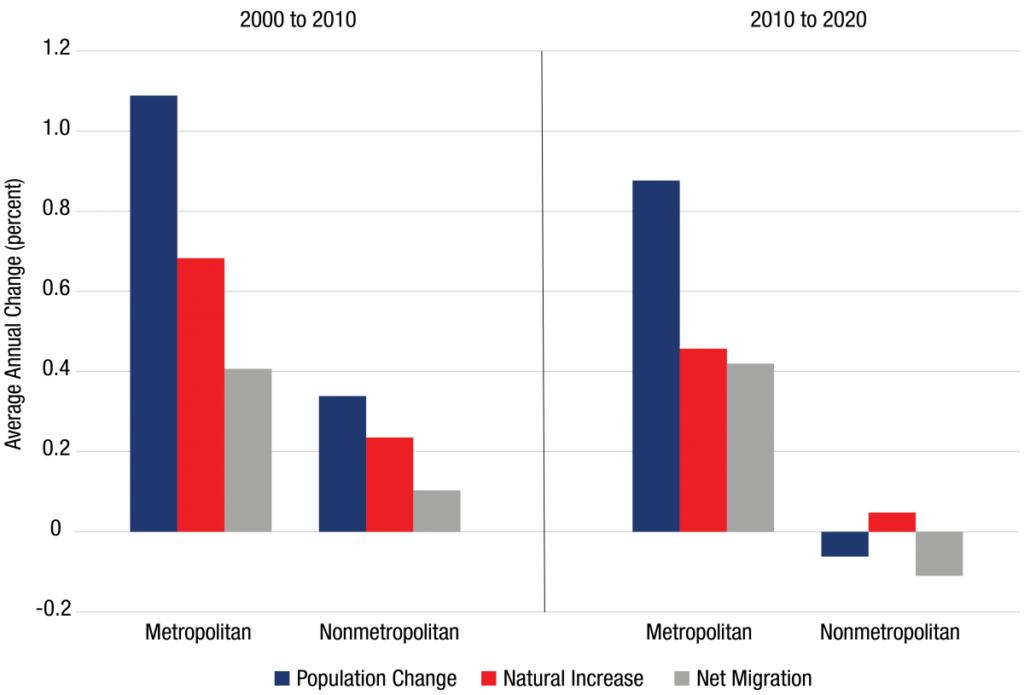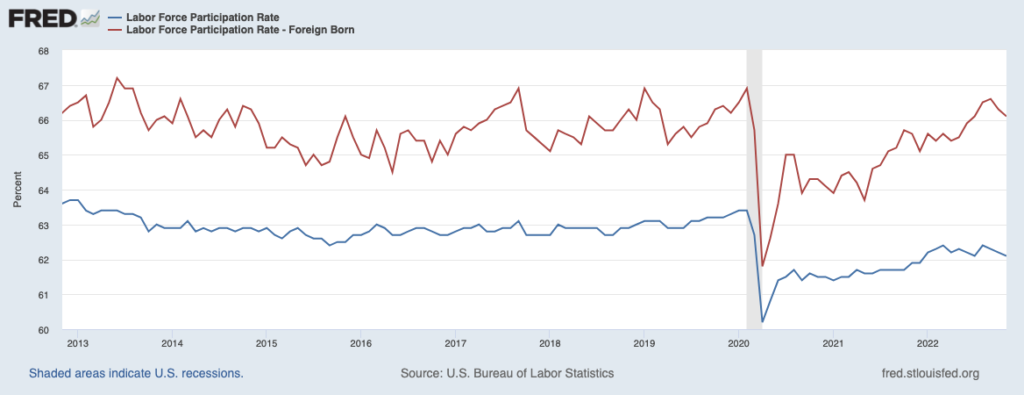
Economic predictions and weather reports have one thing in common—whether it’s rain or shine tomorrow depends on who you ask. One survey of business conditions says that the US has a greater than 50 percent chance of entering a recession in 2023. Another survey of consumer confidence shows people are getting more worried about the future and inflation. But a third view cites the fact that China, Europe, and the US beat expectations for hiring and wages as a sign that we have a bright 2023 ahead. All of that guesswork just in January.
Worries about the national economy make sense. Altering the course of the $23 trillion US economy is indeed a staggering task. But in the face of a potential national recession, local policymakers have more flexibility and tools at their disposal for improving and protecting their smaller economies.
One of the most powerful tools: welcoming immigration policies.
Immigrants have always carried significant weight within American economies. As Los Angeles Mayor Eric Garcetti said in 2017, “People from all over the world are a driving force in an economic resurgence that has seen us create 146,000 new jobs and register 170,000 businesses over the last three years.” Mayor Garcetti was highlighting the importance of immigrants in LA’s strong economic rally during the mid-2010s. As reported in New American Economy, LA has a robust immigrant workforce: “In 2019, immigrants accounted for 36.3 percent of the city’s total population, representing 41.3 percent of the working-age population, and 43.1 percent of its employed labor force.”
In the wake of the 2008 financial crisis, LA gained strength from its immigrant population and actively recruited more foreign-born workers. Today, cities and towns need a similar boost to overcome the ups and downs caused by the COVID-19 pandemic, supply-chain challenges, and record-high inflation.
Immigration can help cities, both big and small. It is an economic steroid that will strengthen any economy. Small towns and rural areas are especially in need of people.
Milan, a town in Minnesota with only 428 residents, is an example of how immigration can strengthen economies of any size. Speaking of immigrants from Micronesia, the mayor once said, “They’ve saved our community. . . . They’ve also made us vibrant. We were losing our vibrancy because we were getting old.” Immigrants from Micronesia revitalized businesses in Milan, which now sell products otherwise unavailable outside of Micronesia, such as bonito flakes and frozen baby octopus. This new business is helping the entire town thrive.
Los Angeles and Milan are not alone. Chicago, Queens, and Buffalo have also experienced this economic-revitalization effect.
Immigration is an effective economic tool that benefits large and small economies.
Immigration works like a fountain of youth for struggling communities
Many economies in the United States are struggling and shrinking. Since 1950, Detroit’s population shrank from 1.8 million to approximately 632K in 2021. It has been in decline for the last 70 years.
Rural America faces similar problems. The rural population of the United States saw a decline of 0.5 percent from 2010 to 2020. At first glance, this seems like an inconsequential change, but this is the first time in history that rural America lost population over a decade according to the demographer Kenneth Johnson.
Source: Kenneth Johnson, University of New Hampshire, Carsey School of Public Policy.
A shrinking population means a shrinking economy. This leads to fewer workers in an area, meaning stores and businesses may close. People start to notice they have fewer neighbors or friends living close to them. Less money is invested in these areas because they are less successful. Quality of life falls, and more people leave the area, leading to a negative feedback loop that is brutal on these economies. These suffering areas experience many adverse economic effects—typically caused by declines in workforce or high unemployment rates—that result in decreased quality of life for residents.
There is growing consensus among immigration researchers that immigrants can end this negative loop. In addition to reviving struggling cities, immigration can grow small towns into big, thriving cities. It prevents population decline and brings an influx of diverse skills and interests into the economy. Research from the National Foundation for American Policy (NFAP) shows that immigration is the only source of growth for rural counties—and a significant reason for the nation’s overall population growth. It made up a third of the growth in the US population between 1990 and 2010.
Immigration’s impact on employment is larger in rural areas compared to large, metropolitan areas. It does more than natural population growth to increase employment and stabilize rural populations.
Immigrants are more likely to participate in the labor force. A larger percentage of them are working-age, 78 percent compared to 59 percent of natives. Economists have also found historical correlations between immigration and increased employment of locals. Foreign-born workers have a higher labor force participation rate than native workers. Injecting a group with a higher participation rate into the population will raise the total participation rate, increasing the output of the economy and bringing greater prosperity.
Source: Federal Reserve Economic Data, as of January 29.
Policymakers who are looking to give a shrinking economy a second chance can do so by making immigrants feel welcome to live and work in their communities.
Immigration diversifies the workforce
Immigration creates “skill diversity,” as explained by economists Ethan Lewis and Giovanni Peri. Their study investigates the relationships between immigration and economic growth. They point out that immigrants tend to be either more or less educated than natives. Most natives have completed high school, and some have completed college. In contrast, the immigrant population tends to have either no high school education or have completed post-graduate education. This suggests that immigrants and natives don’t compete for the same jobs. Immigrants are with other immigrants.
Rather than take jobs, as the rhetoric frequently claims, immigrants like to start businesses and create jobs. In fact, in 2019 there were 3.2 million immigrants who were entrepreneurs in the US. Not only that, research shows that immigrants move to areas with a greater need for their skills. This provides the workforce to grow the economy.
How can local governments take advantage of immigration?
Like all humans, immigrants respond to incentives. Policymakers should offer programs that make it easier and less expensive for immigrants to settle in an area. For example, Dayton, Ohio welcomes immigrants by assisting with language integration, awareness of available support, and access to public services. Dayton has seen great success from these policies and is reaping the benefits. Its once-shrinking population has stabilized. The percentage of foreign-born residents in Dayton is still below the national average, but it is one of the fastest-growing immigrant communities in the nation.
Welcoming America is one of many organizations that help rural communities implement immigrant-attracting policies. Their Welcoming Standard describes what a welcoming community looks like. The organization’s website also provides educational resources for local governments, including research, webinars, and toolkits.
Welcoming America has many initiatives to help communities attract immigrants. Its Rural Welcoming Initiative offers training and support for pro-immigrant policies yearly to 10 rural communities with populations of less than 50,000. The program helps these communities create plans to attract immigrants and help them integrate. The fundamental goal is to create a virtuous cycle of economic growth that offers opportunities to immigrants and natives.
Like Dayton, rural communities throughout the United States need the economic steroid of immigration. Most immigrants are looking for a place to call home. Policymakers can welcome them by creating policies and incentives that make their transition to the area easier, safer, and economically worthwhile.




